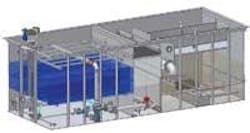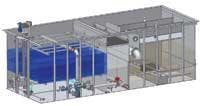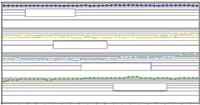Multi-Barrier Packaged Water Treatment Unit
USFilter Microfloc Products’ newest packaged treatment system provides multiple barrier protection for surface water and groundwater treatment. The recently developed Trident® HS unit’s design is based on the Microfloc Trident® packaged treatment technology that consists of adsorption clarification and mixed media filtration.
Used at more than 700 installations worldwide, the Trident process forms the heart of the Trident HS technology. A pretreatment tube clarifier for removal of gross solids and a downstream UV disinfection system for final effluent treatment surround the process, completing the design.
The Process
Before water enters the treatment unit, coagulant and polymer are added to begin the flocculation process. A sludge recycle flow is introduced near the coagulation point, to aid in floc formation. This recycle flow also serves to maintain a steady-stage solids concentration, to dampen variations in influent solids concentration.
The tube clarification stage reduces influent solids concentration prior to the adsorption clarifier stage. For plants incorporating enhanced coagulation, the majority of coagulated particles are maintained in the tube clarifier. The net result of the tube clarifier is an improved downstream operating efficiency. The tube clarifier module can also be retrofit to existing adsorption clarifier and filtration systems to improve process performance and reduce waste.
A buoyant media bed provides second-stage clarification in the process. The adsorption clarifier further reduces solids prior to filtration. Captured solids are periodically flushed from the adsorption clarifier using air and clarified water.
Mixed media filtration removes the remaining solids using a 30" bed depth of anthracite, sand and high-density garnet. The media surface area per volume increases from top to bottom to provide ever-tightening filtration. A direct retention underdrain supports the media. Filter backwashing incorporates simultaneous air-water backwashing and baffled wash troughs to prevent media loss.
Each treatment unit is also equipped with an ultraviolet (UV) reactor for additional disinfection treatment. The UV units are designed to provide 2-log inactivation credit during the filtration cycle.
In-house and field testing results show the Trident HS technology is capable of treating raw water turbidity ranging from 15 to 400 NTU, at both steady-state and variable turbidity conditions. In a side-by-side study comparing the standard Trident system to the new Trident HS system, the latter produced less than half the waste of the standard system, while removing 20 to 25% additional TOC.
The Trident HS system offers small- to medium-size plants a solution for achieving operating efficiency while producing exceptionally safe drinking water.
For more information about the Trident HS system, contact Darin St. Germain at 515-268-8400 or [email protected]. WW


